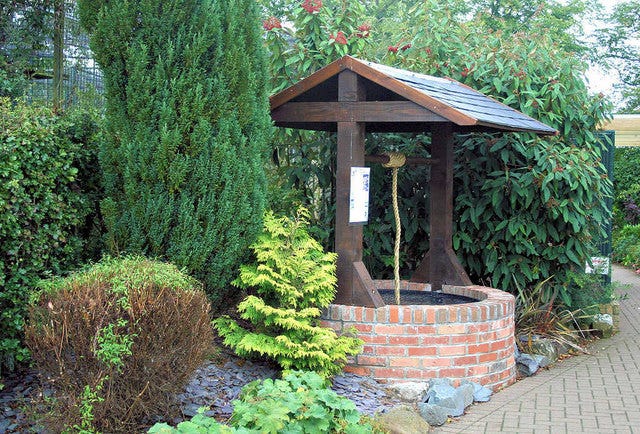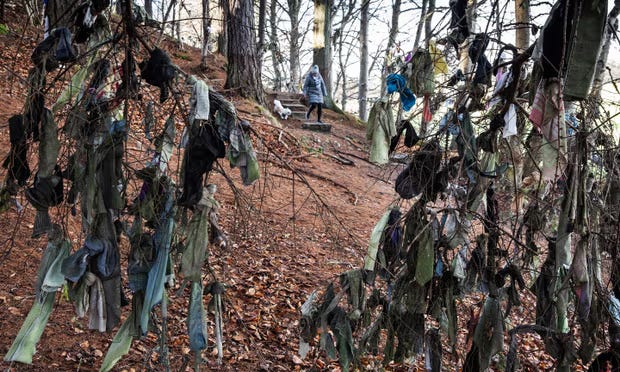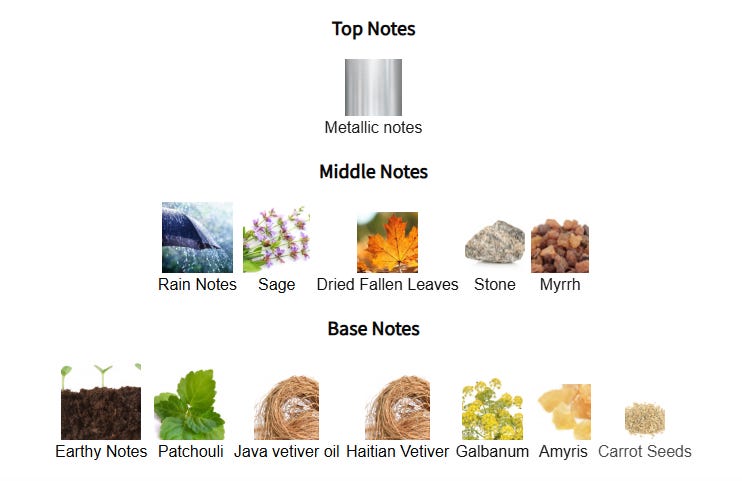I love a conceptual fragrance. Scents that capture moments in time, specific places, or those undefinable feels we struggle to articulate. One concept that I have seen twice now is a fragrance that smells like a wishing well.

Wishing wells and using specific water that’s been imbued with meaning and designated for rituals is a practice that has existed for thousands of years in humanity. In Japan I lived near a temple that existed because monks had stumbled across a waterfall system that was so beautiful they decided to build a temple next to it immediately. The water that comes from that spring is said to help bring clear skin and vitality to those who drink it, and nearby hotels boast tea and matcha brewed with the spring water.
Water that comes forth from the earth and is distinct in a way, whether crystal clear and potable, or steaming hot and mineral rich, has always captivated people’s imaginations and stirred their ritualistic desires. In Norse mythology, the reason that Odin is one eyed is because he went to Mimir’s well (Mímisbrunnr) to ask for a drink. The well was located underneath one of the roots of Yggdrasil, the world tree, and imparted its cosmic knowledge to Mimir, who drank from it daily. Mimir knew how serious a request this was, as it would also make Odin nearly omniscient, and so refused until Odin pledged his eye as compensation. Materialistic trades for otherwordly assistance remains a theme through history.
In Bath, England, archaeologists unearthed 130 Roman curse tablets that were petitions to the Goddess Sulis Minerva, to whom the temple over the hot springs was dedicated, asking her to exact justice on those who had wronged them, usually theft. The curse tablets were small pieces of metal which were inscribed with a formulaic “prayer for justice” that transferred ownership of the stolen items to Sulis herself, then asked her to exact punishment on the thief if the items were not returned (as she had a vested interest in punishing the thief, since the items were now her own). Then, most importantly, the tablets were deposited into a body of water at the temple, fed from the hot springs in the ground, that was sacred to Sulis Minerva.
Even today, people throw coins into nearly anything, from well to cavern pool to fountain, with the hope of securing a wish. In Luray Caverns, VA, there is a pool called the Wishing Well that is illusory and appears much shallower than it actually is. Coin tossing is allowed and every year the pool is drained and the money is collected, then donated to local charities. Frankfurt, Germany has a collection of fountains known as the Wishing Wells that stand as artistic and historic monuments around the city, and act as popular meeting and relaxation places for locals. And what would tourist pictures of the iconic Trevi Fountain be without the coins glinting in the pool? Local lore says tossing coins in correctly1 will favor you with a return trip to Rome, help you fall in love with a local, and even marry them.


It stands to reason then that such an enduring and powerful symbol of fortune, hope, and superstition would capture the imaginations of perfumers.
I do want to point out that these are two extremely different samples, most notably in formulation. Alkemia is a small US company making oil based perfumes and Toskovat’ is a niche designer out of Romania making alcohol based spray fragrances. As a general rule oil based perfumes are often more muted and gentle and sit closer to the skin, while alcohol based fragrances project more and can often allow for harsher, clearer, and more aggressive reads of notes, due to the oil muffling in the alternative. I do not find that either base impacts the longevity too much, that generally comes down to the intensity of the notes, their ratio to the overall formulation, and your own skin chemistry.
Alkemia - Assemblage of Offerings at a Wishing Well
Every year Alkemia does a collection of “Arcanum Experiments” during their mid year sale where they sell vials of, well, experiments. As they write on their website:
Arcanum Experiments are perfuming experiments and happenstance musing from our workroom. While they didn't make the cut to our catalog (or we didn't have enough ingredients to make a larger batch), we wanted to give you an opportunity for some playful olfactory exploration. None of these formulas are written down, making each Experiment unique and unrepeatable.
This is a bottle of Experiment number one, with the concept being clearly written out in the name. Since it is not on Fragrantica, here is the notes breakdown from the website:
Notes: Holy well water, clootie cotton, silver coins, old love letters, bronze charms, copper pennies, incense sticks, divinatory herbs, dried flowers, a splash of old fashioned perfume, lucky stones, glitterati, and more.
For those wondering, clootie is a Scots word that means “rag” or “cloth” and in this instance specifically it is referring to the practice of tying a strip of cloth, or a clootie, at clootie wells. These are wells or groundsprings that reputedly have healing properties. Traditionally, those afflicted with an illness travel to one of these wells and tear a strip of cloth from their clothes, dip in the water, and tie it around a tree or a bush near the well, while saying a prayer of supplication to the deity or saint that was associated the well. As this practice started in pre-Christian times, the cloth would’ve been made from natural, biodegradable fibers like linen or cotton. As the strip of cloth degraded the pilgrim’s illness would lessen until they were fully cured when the cloth, exposed to the elements, fully disintegrated. This practice still exists today.

In 1894 A. W. Moore recorded the process for petition in his paper Water and Well-Worship in Man, saying
The objects were mainly the cure of diseases, but also the acquiring of charms for protection against witches and fairies, and, generally, the securing [of] good luck. The usual ritual was to walk round the wells one or more times sunways, to drink the water, to wet a fragment of their clothing with it, and to attach this fragment to any tree or bush that happened to be near the wells. Then to drop pins, pebbles, beads, or buttons into them, and to repeat a prayer in which they mentioned their ailments.
He also explains that were anyone to desecrate the offerings by taking them, they would be afflicted with the very illness that original pilgrim was seeking to relieve themselves of. While there are minor differences to the process across Celtic areas and times, the idea remains the same.
What I enjoy most about this perfume is that this is clearly a wishing well that is alive and currently in the process of being used. Straight out of the bottle, the most obvious note is the smoldering incense. It is the classic church incense of frankincense and myrrh, sticky, smoky, and heavy. Someone lit it in prayer and has just walked away, leaving it to waft around you and the rest of the items near the well. After about a half an hour this eases, allowing your eye to catch the smaller things scattered around. The incense begins to have a woodiness to it, the clootie tree branches around the well now adding themselves to the mix, and a slight metallic tinge is noticeable underneath. If you’ve ever smelled new pennies from a coin roll, that gentle tang is present here. Next to the metal is the cool, clean water of the well. It’s not cold or rainy, there’s no atmospheric quality to it. It’s more like a quick sip of room temperature water, cool in your mouth, but very very gentle. It floats quietly underneath, there after you’ve nosed your way past the more aggressive notes.
Despite the notes saying flowers, I don’t get anything floral, othering than perhaps a tempering of the incense and metal. This is a true gender neutral, lightly spicy and warm from the incense, but otherwise quite wearable.
After a few hours all these start to melt away, and a gentle, dry base is present. This is where the divinatory herbs and love letters come in to play, because it smells like tea leaves and old book paper. The incense has burned down and you’re left with the rustling of desiccant leaves around you. You’ve been sitting by the well too long and the air is starting to shift, the breeze catching the scent of the dried herbs and stationery and mingling everything together. The acrid tea is separate from the savory letter parchment but only if you focus on it, otherwise the whole thing is gentle and dry around you, reminding you that everything decays. But make a wish anyway.
I like the slight complexity to this fragrance. It opens up and changes, but it doesn’t gallop through its notes. Each comes and goes and makes an impression but it all works together, the smoky incense wafting through the entire composition. The notes list and concept look shocking, but this lets metal and herbs and water be quite wearable. I find this to last quite a while on me, more if I accidentally let the dropper really douse my arm (it got away from me on my third wear and I was stuck in incense purgatory for several hours). I have to be careful wearing this too close to my face because even a small dose can give me a little headache, but the performance is amazing for an oil fragrance that I got for $5! Alkemia seems popular for their heavier, stickier, and more gourmand offerings and this notes lists aligns with hallmarks of their most popular and high performing fragrances.
Toskovat’ - Empty Wishes Well
Here lies the antithesis to Alkemia’s vibrant, living well, Toskovat’s overgrown and forgotten one. You’ve been away from the well too long and it languishes, shrouded in trees, covered in moss and lichen. You find its old bones in the forest, like a watchful spirit, as it begins to rain.
This is first and foremost a green fragrance. The well is not being used, there are no offerings, it’s just you, the forest, and the well structure. This starts off with an almost savory aldehydic green note. It gets into the air and you can practically taste it. This evokes the moment when it begins to softly rain and the plant oils get released and seep into the air, rising up from the ground like vapor, mixing with the humidity to hang heavy in the air. A similar moment, for the urbanites, is when the produce misters go off in the grocery store and suddenly the smell of green pepper and cucumber washes over you. The metal of the well also releases a slightly tangy smell as the water runs over the spreading rust, the metallic note making the hairs on the back of your neck rise. The stone emerges next to the metallic, trailing slightly behind it. The cool of the metal meanders into the cool of the stone, the only difference is the stone isn’t quite as sharp in the nose. If anyone else out there was a weird rock sniffing kid, then you’ll understand what I’m about to say: this smells like one of those gray/white striped river stones, the one that’s still slightly rough on the outside and is cool to the touch.
The earthiness helps take the edge off, the comforting smell of wet soil mixing with the aromatics to ground you. This really starts to open after 3-4 hours on the skin. For a composition that has patchouli and myrrh, there’s little spice. Vetiver on its own is generally quite a dry, hay-like scent, which pairs nicely with the fallen leaves accord. Carrot seeds are similarly dry, the husk hiding a savory, nutty sweetness. It reminds me more of the smell of a roasted carrot, after you’ve caramelized the natural sugar in it, rather than the bright smell of raw carrot, however it’s very muffled. The earth note is reminiscent of cool, damp soil, which mixes with the patchouli for that “wet leaves” smell you get in early autumn rains.
As the fragrance fades out, because I find it gets less intense as the hours pass, the last few remnant of it is the chill, damp earth. The aldehydes and metallic notes have burned away, the rain has passed. The aggressive green from the plant oils in the rain has also passed, there is no more sage or myrrh. The vetiver has gotten soggy and everything has settled down, barely even there when you smell your wrist, only whispers of it around you if you sit still and sniff for it. The wet forest floor has bogged down all other smells. Night is falling, the rain has made everything chilly, and the well still sits, forgotten, as you button your coat and turn away.
The complexity of this fragrance was really intriguing, and kept me checking my wrist all day to see what it would do next. While I can’t say that if I smelled this without reading the label I would immediately imagine a wishing well, empty or not, I do like the scene it sets for the notes to follow. It’s pretty easy to conjure one up with the atmosphere the fragrance creates, and gives a reason to use a very fun combination of notes. Stone with herbs and metal might otherwise make you think of a mortar and pestle or someone’s lost bike. This lasted a solid 8 hours on me, with the intensity starting to decline after about 2 hours (this makes sense as metallics and aldehydes tend to propel the scent into the air but these do burn off) and over the course of the day just got closer and closer to where I sprayed it while continuing to evolve the notes. I do also think this is very unisex with just a little more masculinity coming from the wet earth notes. Not saying a woman can’t wear this, just that I would be less surprised to smell this on a man than a woman.
Overall
These are such different interpretations of a wishing well, one alive and the other not. This also means that they are very different types of fragrances, one being an aromatic, warm, spicy fragrance, heavy on the incense and dried herbs, the other being an aldehydic fresh green, with metallic and vegetal notes being prominent. What I can say though, in terms of artistry and conceptualization, is that I think both are really neat approaches to the idea of looking at a wishing well and what you might smell. What does it smell like to stand next to one in use, how would all the offerings affect the atmosphere around you? And what happens when it gets abandoned, what does it smell like to find it alone in the forest? I really love the artistic license and challenging combinations of notes presented in both.
The big sticking point would be price. Alkemia is much more affordable and while the notes are a little less elegant than Toskovat (and I cannot explain what I am trying to say without saying that, in the kindest way possible, Alkemia does smell like something you can buy at your local health food store or hippie shop. I don’t know if it’s oil or the actual manufacturing process of the notes, but Toskovat’s notes are very realistic and refined smelling. It smells like a luxury fragrance) $265 for what basically amounts to a petrichor fragrance is a little eyebrow raising. However, if the elegance and blending of the notes is worth it, I could see Toskovat being an easy reach for most days.
Both make me excited to try more from the brands and see where their creativities lead. I also hope both brands continue to push the envelope in their note combinations and fragrance concepts.
I also hope you start carrying more coins for tossing in the future. You never know when a wish will come true!
Toss the coin using your right hand and toss over your left shoulder. One coin for a return trip, one coin for falling in love with a Rome local, and one coin to marry them. Each must be tossed separately from the others, so three throws in total.




